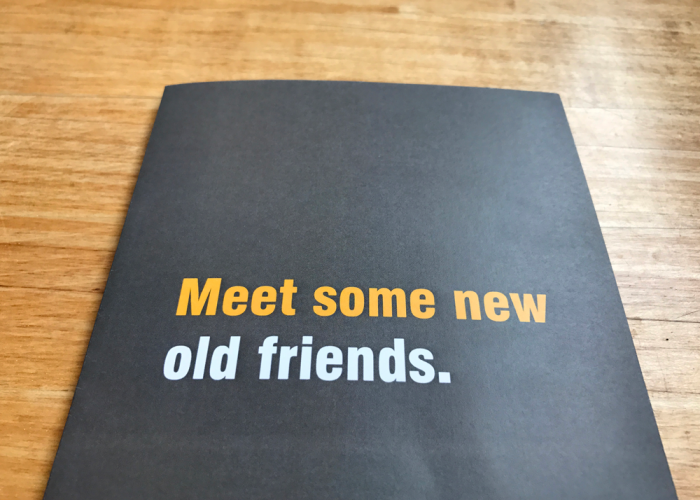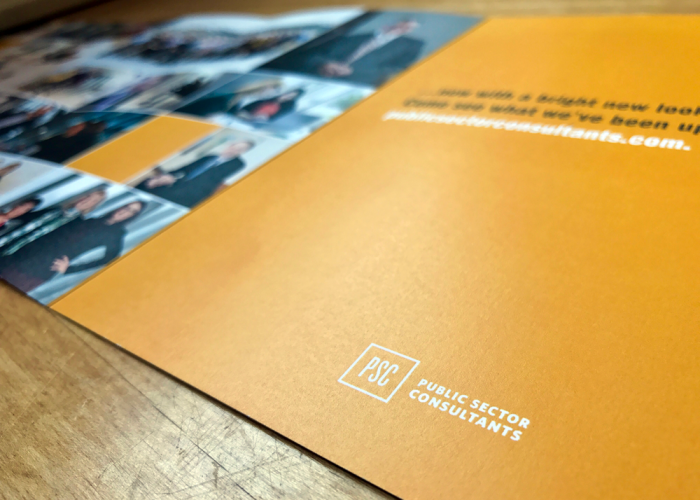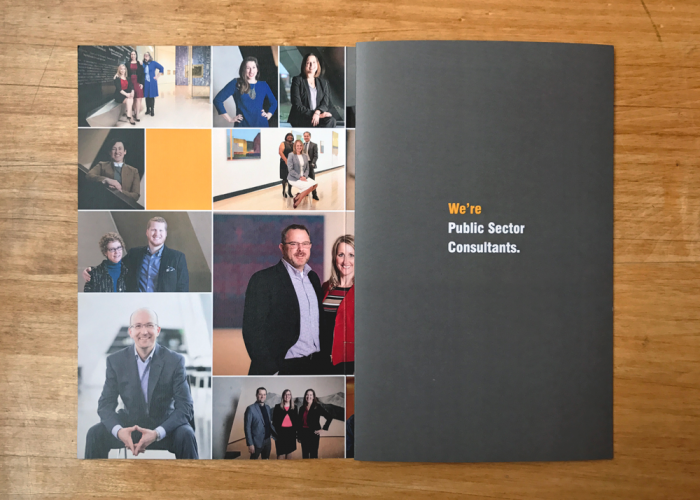At Redhead, we do our fair share of rebrands. One notable similarity—rebrands take time. Planning and more planning. Soul-searching on the client’s part; deep probing on ours. There are scores of small details to attend to. It’s not only an exhaustive process for us, but it’s a significant commitment of time and resources for any company embarking on the rebrand.
Which is why Public Sector Consultants stood out. They recently underwent a rebranding with us. If you think that means we made them a new logo, letterhead, and some business cards, you’re only seeing one piece of the brand development landscape. PSC’s process was a deep overhaul, and we’re not exaggerating when we say they did an exceptional job with regard to process, commitment, and successful deployment. They did nearly everything right.
So, I sat down with Jeff Williams, Public Sector Consultant’s CEO, to talk about the process from his point of view. If you’re thinking about going through something similar for your organization, this might be a great resource.
Jen: What made you decide to rebrand? Why now?
Jeff: There were several things that informed the decision. We’d recently moved into a new, more modern office and had a number of new faces. That refresh made our existing brand feel dated. We’d lived with it for almost 15 years, it was time to freshen up. We also realized we had been working with a number of outside contractors for a variety of projects. If you totaled up the dollar amount of all those contracts, it was more than [we paid] a staff person. So, we made the decision to add a director of marketing and communications, Selma Tucker. He had known us as a project partner for several years, so he was uniquely able to give us the outside world’s impression.
Finally, our website. If you went to our website not knowing us, you would have found there was a huge gap between what we actually do and what our clients thought we did. And we didn’t come across as qualified or as experienced as we were.
Jen: Agreed. There was a disconnect between the projection of your brand and your brand’s reality. We call this a rebrand, but it felt very much like uncovering your actual brand, sort of illustrating what PSC really was instead of a facade.
Jeff: Well, it’s who we used to be. When you’re 15 years old as a company, you get a different set of phone calls than when you’re close to 30 years old. So, between the new office space, our marketing position and several new team members, it was time to say, “It’s time.” Even our website—it was state of the art when it was built, but technology advances so quickly that sometimes you just need to start over.
Jen: It’s funny, too, to hear you say that. I find, oftentimes, there’s some tactic, some material, some piece, that is a tipping point. But you can’t really move forward until you figure out some foundational stuff: Who are we? Where are we going? Strategically, what do we want out of the next decade?
Jeff: This was three projects in one. First, we’re researchers. We know our decisions have to be grounded in data. “Who is PSC? Whom do we compete against? What do you think of us? What’s your image and impression of us?” That was the research phase in which you all played a critical role.
The second was that brand part. That’s where we were very intentional this time. There was a hunger from staff who were really struggling with, “How do I say what I do for a living?” There was a staff demand for, “What’s our line?”
To start, our internal marketing and communications team very smartly filmed each of the firm’s shareholders describing PSC. They were then able to pinpoint the common themes that emerged from those interviews as well as the places where it seemed we were three different companies. That was a tremendous help in illustrating the problem at hand—the problem we needed our rebrand to fix. That was a really instructive, important part of the process.
Part three was the implementation—the new logo, color schemes, materials suite, messaging, and launch concepts that you helped us with, and also the new website, which our team worked tirelessly on in conjunction with another excellent outside partner. Even the new way we’re doing proposals now—having a formal proposal template and packaging that serves as a cohesive marketing tool—which our design staff did an excellent job developing—is important. It was really a commitment from the employees who wanted one way to talk and the shareholders saying, “That’s fine if you want one way to talk, but we’re going to politely, softly, correctly, enforce our brand standards and promise.”
Jen: And then to turn all of this work into action, you put a cheat sheet into everyone’s hands. Which is good to hear from our standpoint, because oftentimes, people go through this process and they leave the things on the shelf. Actively referring back to your branding work and giving it to your staff is so important.
Jeff: The key internal piece that drove home the new brand position for the staff was the pocket-size brand voice booklet that our [Marketing and Communications] team crafted. It keeps everyone on message. It’s made to stick in your pocket or throw in your bag before you walk into an event where someone will ask, “What do you do?” It’s a tactile piece that says, “When you’re stuck, say this.” When you’re giving an interview, we now have the same three sentences to explain how we work. Our logo isn’t our brand; it’s the language we use, how we talk about ourselves, that’s our brand, that’s our mission.
Jen: Speaking of, it really wasn’t in our scope to audit your mission, but after the research phase, it was obvious to us you needed a mission rewrite as part of this brand refocus.
Jeff: That idea is something Redhead absolutely brought to the table—connecting our brand to marketing and to physical products within a vessel, a mission, vision, values that look like PSC. We had a very thorough internal vision, but as you pointed out, we needed to make it clearer, more concise, and more consumable for external audiences. Although the words are all ours—as you know we’re very particular about language—the process piece you helped with was very useful. You laid out the case beautifully and really pushed us to do more, and that’s exactly the kind of outside counsel you need in these things.
The Oreo sandwich approach worked really well on this project. We had Selma, PSC’s internal brand champion, in charge, working with our highly skilled internal marketing team managing the process, developing materials, and deploying the launch. They’re the two cookies. The filling in the middle, which everyone loves, was a number of different partners, including Redhead, each adding value in their areas of expertise.
Jen: What I really enjoyed was seeing that every medium, every nook and cranny, everything was thought out. We had lots of conversations with your marketing team about how this or that should deploy. That thinking felt very deep. And the rebrand debuted so elegantly, which is fairly rare. How heavy of a lift was that for them?
Jeff: It takes a lot of effort. For example, the brand launch party we had for our internal staff—our team expertly conceived and stage managed. We walked into a dimly lit conference room, they showed us our new brand video, which they wrote, narrated, and produced, and then, when they flipped on the lights, we saw our new logo and big pictures of all our faces on the wall, branded swag on our chairs. We immediately felt like we were living it. Everyone looked at it like, “That would be a cool company to work for. Oh, wait, it’s my company.” It takes good project management, money, time, and attention just to think through all of this.
Jen: Were there any surprises for you or any parts that took a twist you didn’t anticipate?
Jeff: I mean, as a manager, of course. It took too long, it cost too much. But no, that didn’t surprise me. We set our expectations at nine to 12 months, knowing it would go to 15. Actually, it probably took closer to 18 to 20. But the brand identity package was more than I had hoped for. The re-messaging of our words into a different package, so that when I read the words and was like, “That’s what I meant!” and it was consistent—that was better than we thought.
I think, once a decade, it’s good to put your pencils down, lift your head up, look around and say, “Does this representation—whether it’s a website, whether it’s a pamphlet, whether it’s a proposal, whether it’s a report—does this reflect who we are and who we want to be?” Colors change, fashions change, it’s noticeable. It’s about finding that right balance for your organization and clarifying your voice.



Doing this work “right” requires time, commitment, and clear roles. The full breadth of Redhead’s work with PSC included managing research, developing a brand voice and visual language, creating a marketing plan and delivering website strategy. The rest of that cream filling Jeff mentioned? Props to Kearney Associates for research and consulting, CARNEVALE for website development, Mindutopia’s Rudy Malmquist for photography and BSC’s Bradley Scott for videography. And of course, PSC’s internal marketing team, who worked diligently to ensure every medium was in alignment and ready to go when the company flipped the switch.
Embarking on your own organizational rebrand? You might find our downloadable planning list helpful. Or give us a call, we’d be happy to help you get started.
